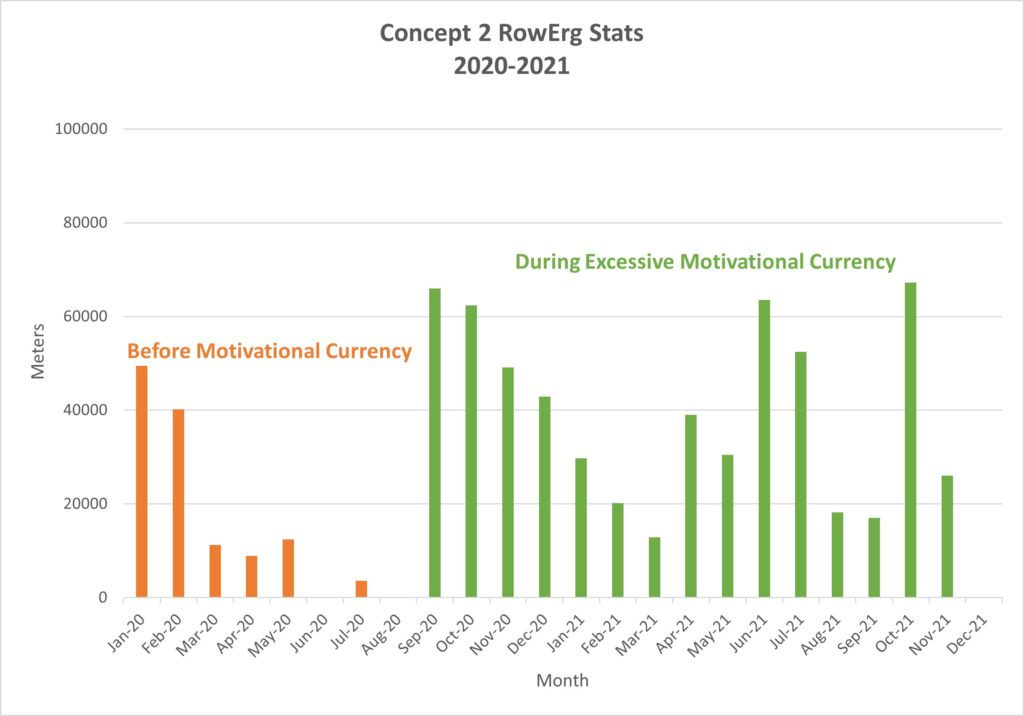What’s in it for me?
Better health. More energy. Clothes that fit well. A sense of accomplishment.
Ah, but what’s the catch?
Hard work. Time. Sweat. Callouses.
Look. I’d love to be in shape, but I struggle with self-discipline. I want to take care of myself, but I just can’t stay motivated.
I understand. I had this same struggle until I discovered how to reward myself with motivational currency.

Table of Contents[Hide][Show]
What is motivational currency?
Motivational currency is a specific reward designed to help you achieve your goals. In order to work, it must be so compelling that it will continue to push you toward success long after all other natural incentives fail.
My motivational currency is just that – currency. Because I like to have a little spending money each month, money is a great motivator for me. Rather than just receive an allowance each month with no strings attached, I decided that I had to earn my allowance by exercising.
Below, I detail just how successful motivational currency has been for me over the past few years. While I think the data clearly speaks for itself, you be the judge.
My Story
Excessive Motivational Currency {September 2020-November 2021}
When I first began rewarding myself by exercising, I sought to increase my allowance. At that time our income and budget could handle this extravagance. I set my rate at $5 per kilometer, an amount which astounds me as I write this years later.
At the end of each month, we tallied my meters to determine my total allowance for the following month. This worked well for the first few months, but as the chart shows, my commitment to rowing was still sporadic. Some months I rowed over 60 kilometers; other months I rowed under 20 kilometers.

I wouldn’t call this a resounding success, but at least I was still rowing some each month. However, it would be some time before I figured out the right balance of work and reward to truly be successful.
No Motivational Currency {December 2021-December 2022}
Then, our budget changed drastically due to a career pivot. I would still receive a monthly allowance, but it would be capped at fifty dollars. This amount was not enough to entice me to row, so we removed rowing as a requirement for the allowance.
The moment I stopped earning my allowance by rowing, I stopped rowing. None of the intrinsic benefits of rowing could motivate me to keep going.
In the summer of 2022, my dad’s health took a sharp decline. Although this sparked my desire to row again, with the exception of a few sessions in September and a few in early November, I simply could not discipline myself to exercise.
Then I decided to participate in the Concept 2 Holiday Challenge to row 100 kilometers between Thanksgiving and Christmas. I had never rowed that far in such a short time period. I prioritized rowing even during the busy Christmas season, and I met my goal. When we returned from Christmas travels, I decided to row to a full 100 kilometers for the month of December.
Reasonable Motivational Currency {January 2023-present}
As we planned our budget for 2023, my husband suggested that we both stop receiving any monthly allowance. I did not like this plan at all. We had gone without an allowance in past years while aggressively paying down debt, and that had been too restrictive for me.
Then I had an idea. I asked to reinstate motivational currency but with different rules. This time it would be all or nothing. If I rowed 100 kilometers in the previous month, I could receive my $50 allowance that month. If I missed this mark by even a kilometer, I would forfeit my allowance for the month.

In 2023, I rowed 100 kilometers every single month. That more reasonable allowance and the all or nothing mindset completely changed my motivation to workout. I still have months where I fall behind, but I continuously strive to make up those meters before the deadline.
Want to know if I’m still keeping up with my rowing? Check out my Concept 2 RowErg Logbook.
Finding Your Motivational Currency
Think about the things you do on a monthly or weekly basis that you could live without but enjoy having or doing. In my example, motivational currency is money, but it doesn’t have to be. It could be time spent on other endeavors like watching TV or playing video games. It could also be routine trips to a favorite coffee shop, restaurant, or beauty salon.
Guidelines for Motivational Currency
1. Take away something you already have.
Rather than adding a new reward as a motivator, consider taking away something you already have, and then earn back the right to that item. When you take away something you already have and rely on, the pain point of losing it is greater than losing something you’re not already accustomed to having.
2. Set a time period to earn back that motivator.
Because we budget a month ahead, it made the most sense to set up my motivational currency on a monthly system. Meeting my 100-kilometer quota for one month translates to receiving my allowance the following month. I can pace myself during the month to reach my goal and even overcome setbacks that occur.
Depending on your motivational currency, a weekly time frame may work well also. I would hesitate trying anything shorter than a week as any setbacks will be felt immediately and may cause your motivational currency to fail.
3. Find something that is easily measured.
Money in our budget and meters on the rower are both easily tracked. This has made keeping up with “earning” and “payout” extremely easy. Try to find a motivational currency that is simple to measure and track so that you can stick with it.
Accountability
One reason that motivational currency works so well for me is that accountability is built in; my rower tracks my meters for me. Depending on your goal and motivational currency, you may need to establish accountability with someone. Another great option is to create a chart to help you track your progress.
Other Goals for Motivational Currency
Goals used with motivational currency aren’t limited to physical fitness. Here are some more ideas that could work well with motivational currency.
- Reading more books
- Spending more time in prayer
- Journaling on a regular basis
- Getting more sleep at night
- Reducing screen time
- Remembering to take vitamins
- Cleaning the house
- Creating and sticking to a budget
Ready to give motivational currency a try?
Email me with your plan and progress. I’d love to encourage you as you reach your goals by establishing a reward system that works for your individual needs.
